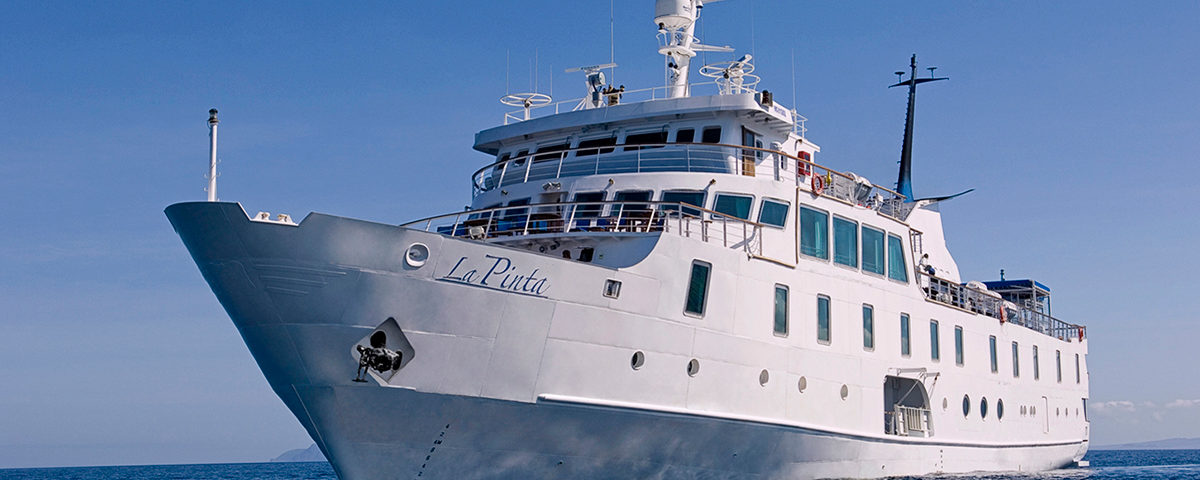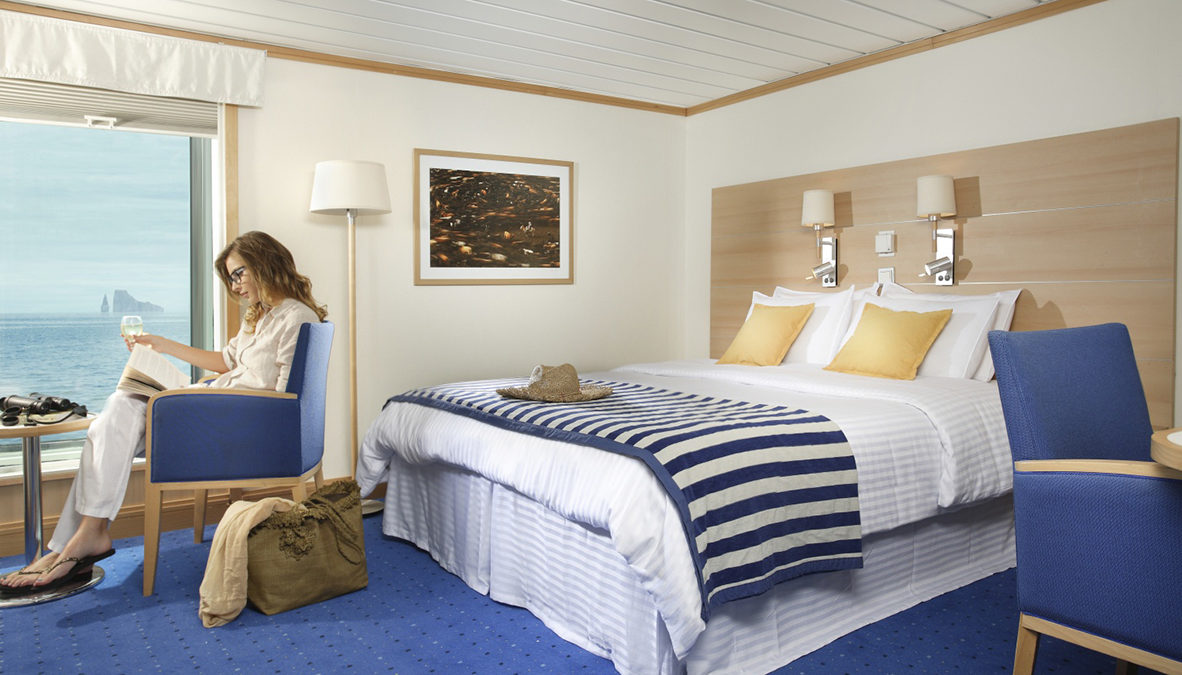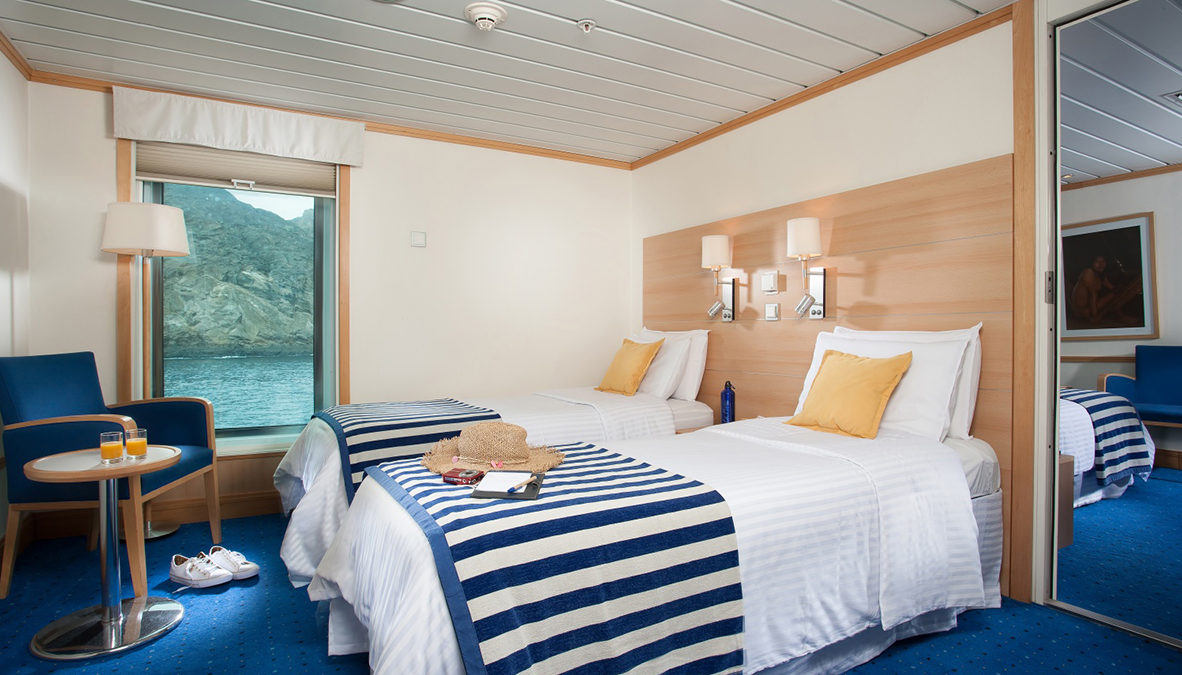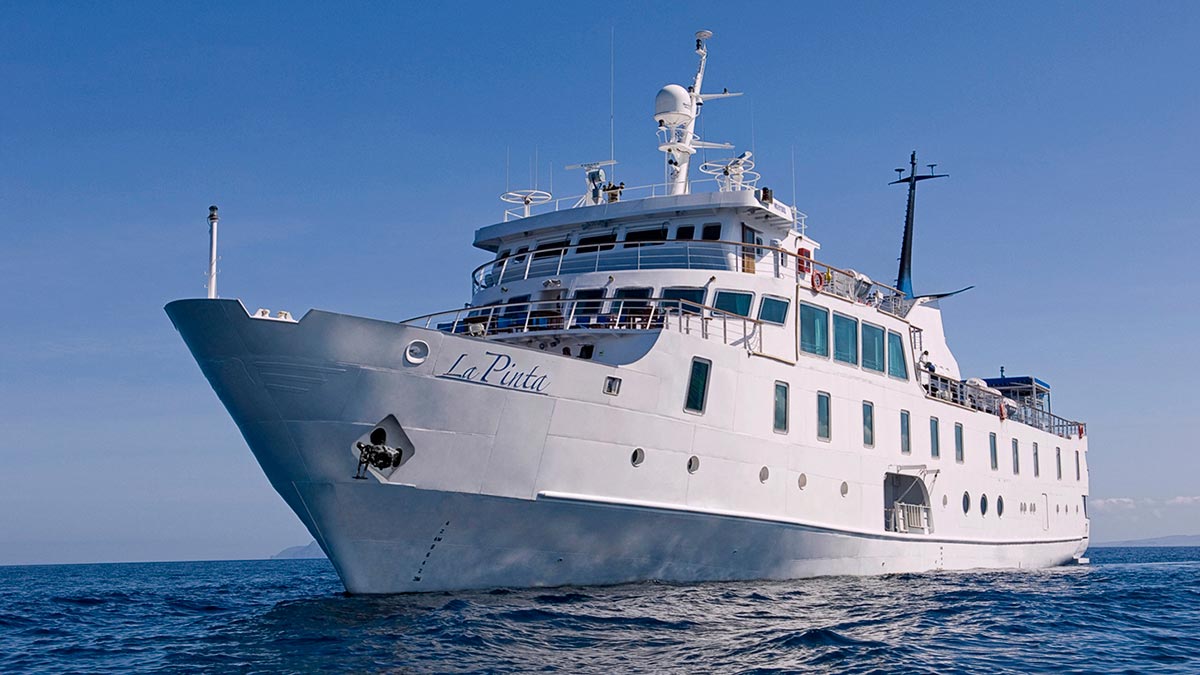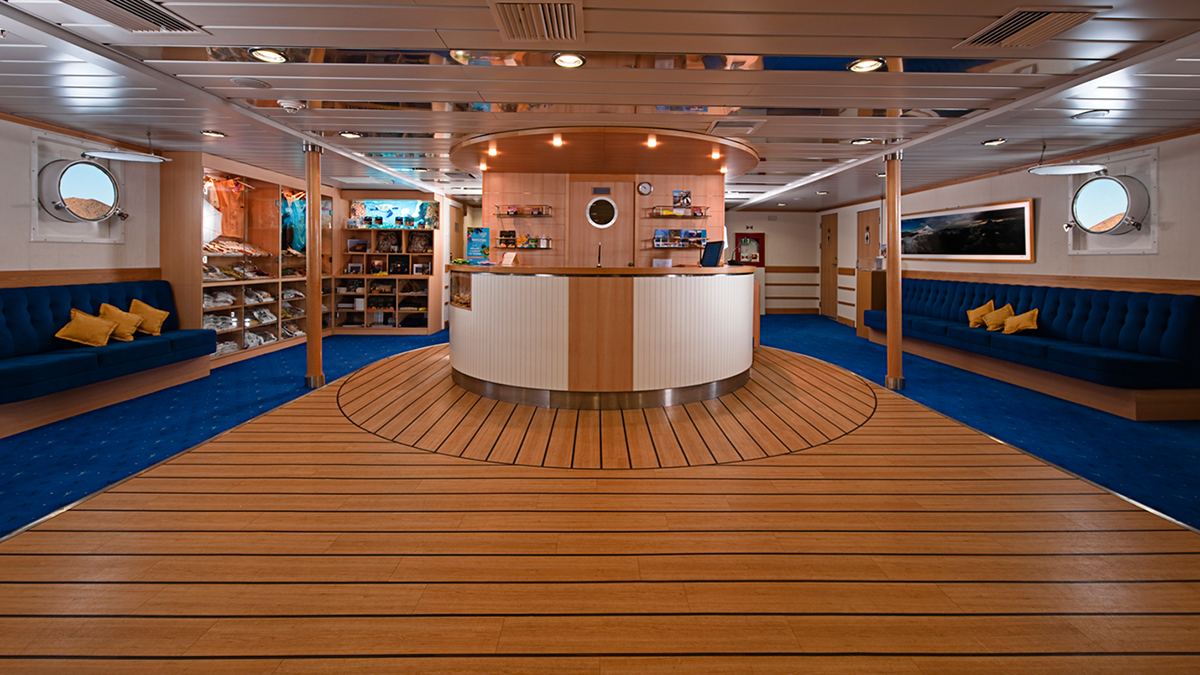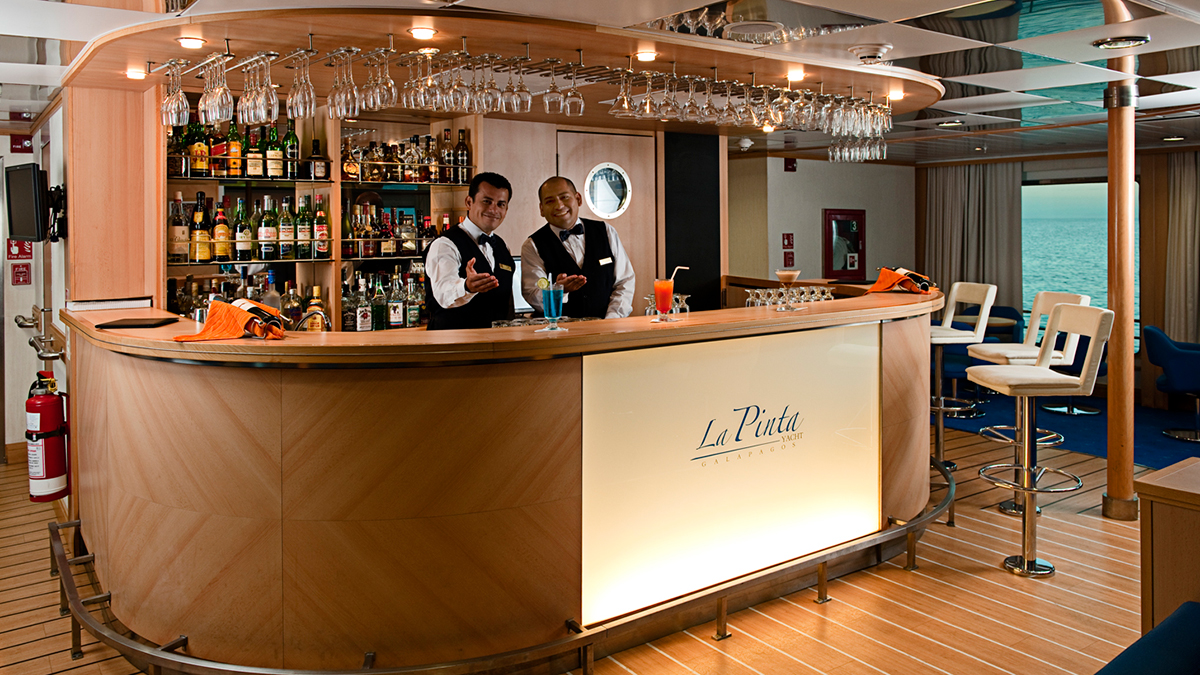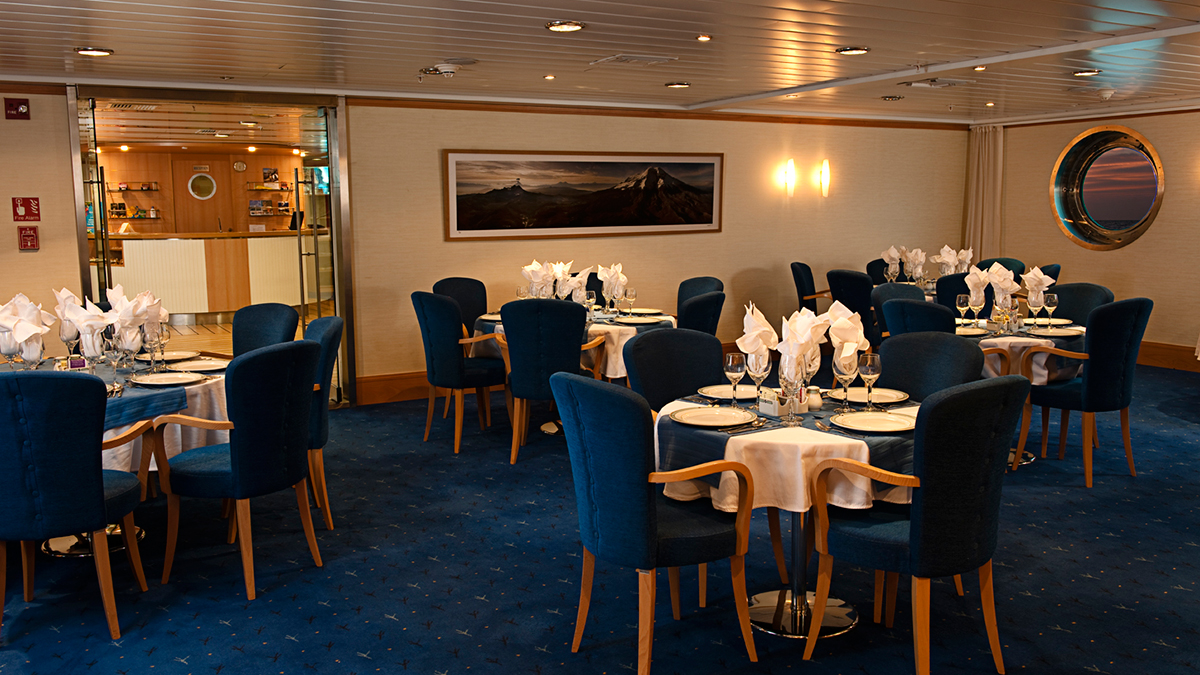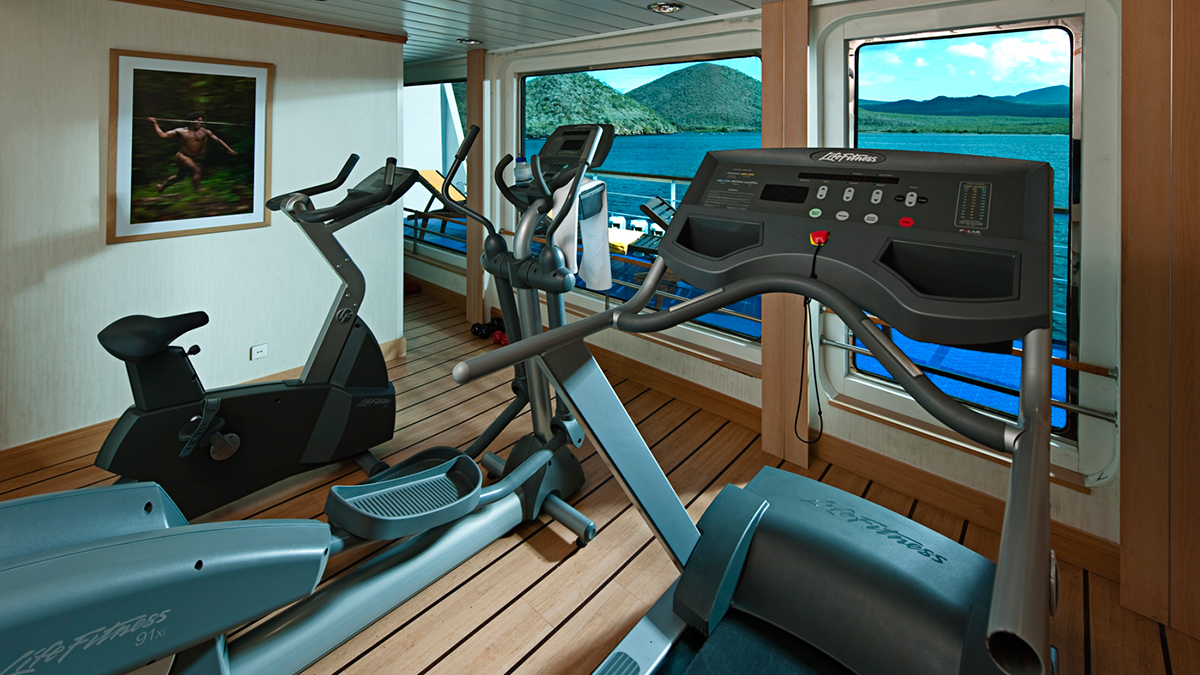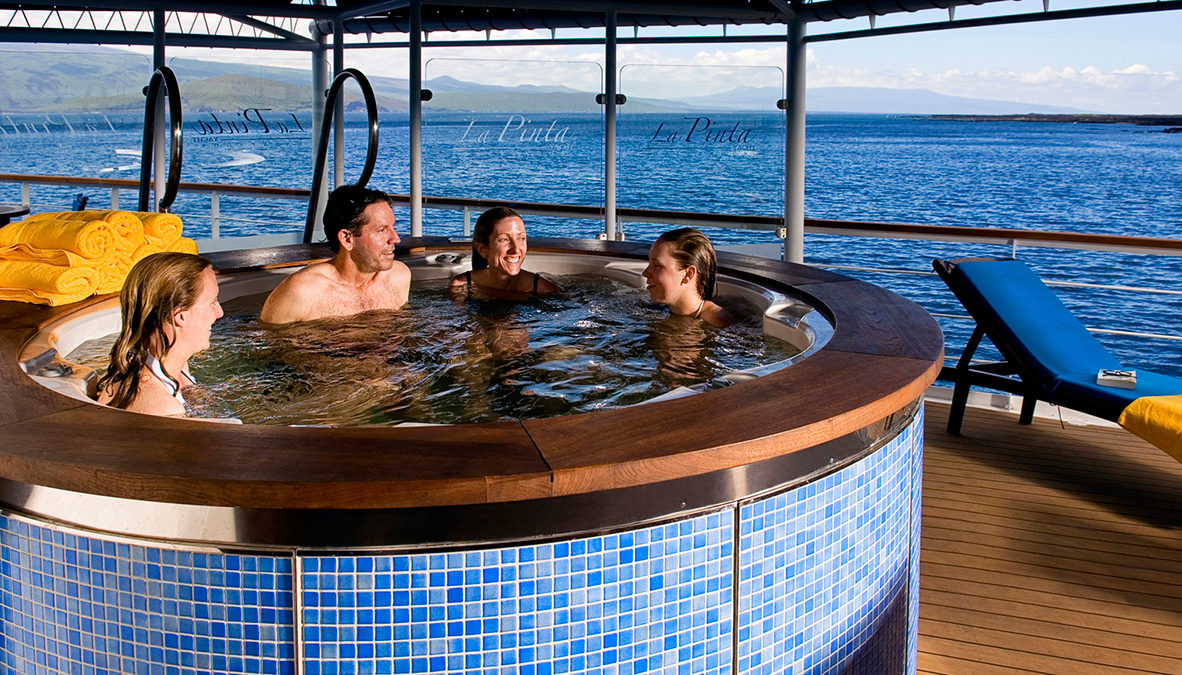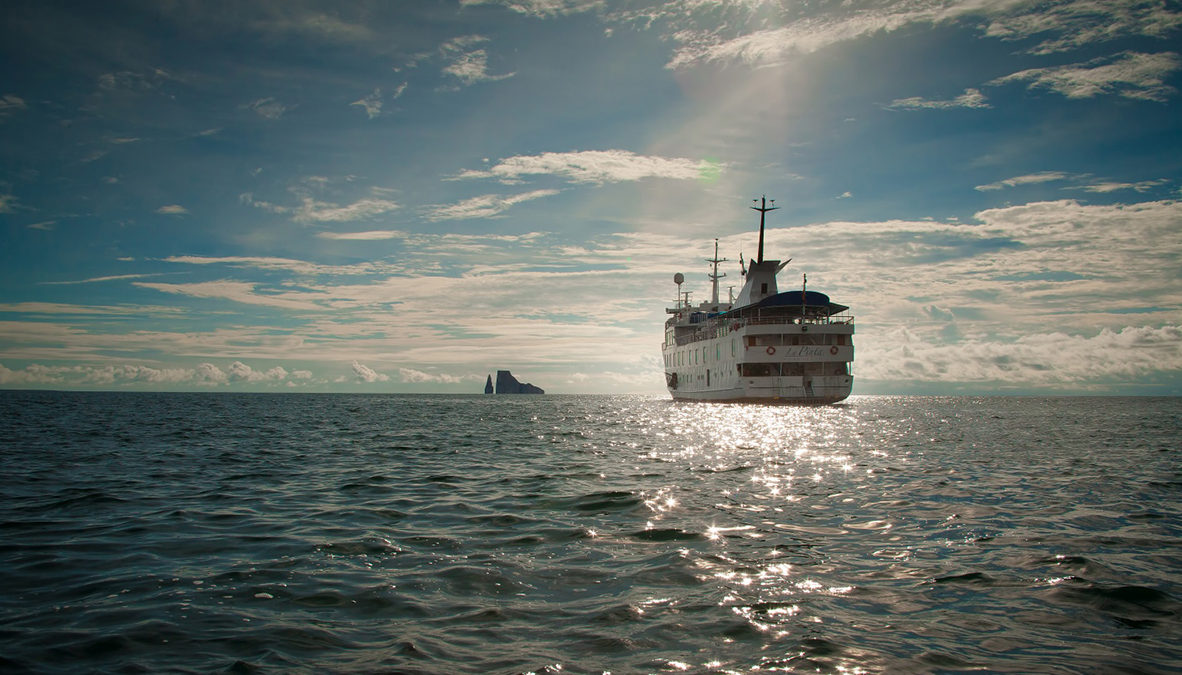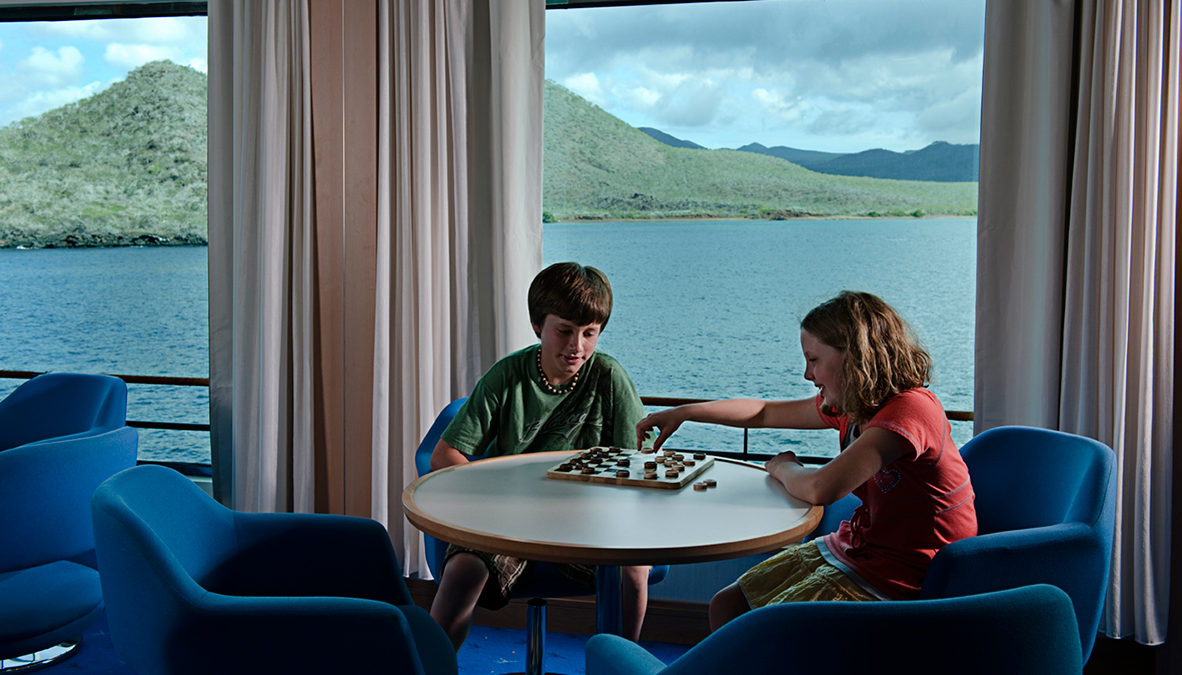
Eastern Galapagos Itinerary 5 Days 4 Nights
Baltra Airport
Our adventure begins with a morning flight to Baltra Island and immediate transfer to the dock to board Yacht La Pinta. There’s a welcome introductory briefing, boat drill, cabin assignment and then lunch. We weigh anchor and start sailing for our first afternoon outing.
South Plaza Island
The turquoise waters of the channel here contrast brilliantly with the white sand and black lava of the shoreline, while a carpet of scarlet sesuvium succulents serves as groundcover for a grove of luminescent green prickly-pear cactus beyond, populated by yellow-grey land iguanas. Along the coastline one finds sea lion colonies, while sea birds play with the thermals that form along the cliffs of this small but spectacular island.
Day 2: Friday
Santa Fe Island
We take the dinghy over to this idyllic sandy-white beach populated by colonies of sea lions. Galapagos hawks are often easily observed, perched atop salt bushes. The Santa Fe land iguana, unique to just this island, may be spotted during the walk. Following the walk, we can snorkel and swim along a natural wave barrier or ride the glass-bottom boat.
Cerro Colorado Tortoise Habitat
After lunch, we disembark at Puerto Baquerizo Moreno, the island’s capital, and drive 40 minutes to the island’s southern shore. At Cerro Colorado, we visit the breeding centre for highly endangered giant tortoises in the midst of a fantastic deciduous forest, home to dozens of bird species, including the San Cristobal mockingbird, and the San Cristobal lava lizard, both island endemics.
Day 3: Saturday
Punta Pitt (San Cristobal Island)
We land at the eastern tip of San Cristobal Island this morning. The trail that ascends from the beach provides spectacular views of the shoreline; we can observe frigates, plus a colony of bachelor sea lions. After the walk, if conditions are favourable, there is a chance to swim from the beach and snorkel.
Cerro Brujo
In the afternoon following lunch on board, a dinghy ride along the shores of tuff-stone layers takes us to Cerro Brujo’s expansive, white coral beach, great for walking, with rewarding bird-watching featuring seabirds and shore birds. Also, look out for Galapagos sea lions. These are the same shores that Charles Darwin walked upon, back in September 1835.
Day 4: Sunday
Punta Suarez
Our morning outing at Punta Suárez provides an exciting walk on lava/boulder terrain to visit its unique sea bird colonies, including the waved albatrosses (April – January), boobies, swallow-tail gulls, and the famous “blowhole” lava formation. Also, look for red-green-black marine iguanas. Many regard this site as the best in the Galapagos. Back on board for lunch.
Gardner Bay
In the afternoon, we set down at this beautiful, white coral beach for a short walk to observe the sea lions, mockingbirds, finches, or enjoy the beach. There is great snorkelling in this area, or else there’s time to kayak or ride the glass-bottom boat.
Day 5: Monday
Charles Darwin Research Station (Santa Cruz Island)/ Baltra Airport
Disembarking in the morning, we visit the Charles Darwin Research Station and the captive rearing programme for the giant tortoises. Here we witness the efforts and results of Galapagos fieldwork and study done in the name of science. We transfer via bus across Santa Cruz Island and a short ferry ride to Baltra. Our journey ends at Baltra Island, where we transfer to the airport to take the flight back to the mainland. Baltra’s flat substrate (due to its uplifted origin) is the reason why the island was chosen back in the 1940s as the construction site for an airport.
Northern Galapagos Itinerary 5 Days 4 Nights
Day 1: Monday
Baltra Airport
Following our morning arrival at Baltra Airport, we transfer to the Itabaca Channel, taking a small ferry across the channel to the north shore of Santa Cruz Island. We board our bus to the highlands, where we’ll learn about Santa Cruz’s unique ecosystems and biodiversity. Lunch is served at a local restaurant.
Highlands (Santa Cruz Island)
After lunch, we continue by bus to reach a reserve that is one of the best places in the archipelago to see giant tortoises in their natural habitat. The tortoises are easy to spot, lumbering around, eating grass and leaves and wallowing in the small pools. There are several lava tunnels in the reserve, too. A short bus ride takes us down to Puerto Ayora to board Yacht La Pinta.
Day 2: Tuesday
Eden Islet (Santa Cruz Island)
After breakfast, a panga ride takes us to Eden Islet, located off the coast of Santa Cruz, where we can observe blue footed boobies diving into the water, reef sharks and frigates. There’s a chance to snorkel and, if weather conditions permit, to ride in the glass-bottom boat. The volcanic setting of this area is quite stunning due to its variety of volcanic debris, including cinder cones, tuff cones, and semi-eroded lava flows.
Sombrero Chino Islet
The tiny island of Sombrero Chino gets its name from its appearance, reminiscent of a Chinese hat. This islet, formed only fairly recently, makes a beautiful visit as one explores the wildlife along its 400-metre long trail, which begins at a crescent-shaped white sandy beach. The cove offers excellent swimming and snorkelling opportunities amid white-tipped reef sharks and Galapagos penguins.
Day 3: Wednesday
Bartolome Island
This morning, a Galapagos icon awaits: Bartolome Island. A great way to start the day, with a steep climb up a wooden staircase: the view from the top is worth the effort! Following the walk, we take to the dinghies for a ride around colossal Pinnacle Rock, followed by time to enjoy the beach and some snorkelling. We can also ride in the glass-bottom boat for great views of the underwater world.
Sullivan Bay (Santiago Island)
After lunch, we board the pangas to land at Sullivan Bay on the east coast of Santiago, a white coral sand beach great for swimming and snorkelling, and with a trail over a lava field that flowed here less than 100 years ago. This is the perfect place to see and feel the volcanic origin of Galapagos while observing its wildlife.
Day 4: Thursday
Darwin Bay
In the morning, we begin our exploration of this island with an easy stroll to observe marine and land birds. There is an optional walk over sharp lava and uneven terrain for dramatic views, or else we can return to the beach to enjoy swimming and snorkelling at this beautiful natural harbour. The more adventurous can snorkel along the cliffs or paddle sea kayaks.
Prince Philip’s Steps (Genovesa Island)
The afternoon starts with a very interesting panga ride along the cliffs before we disembark for a short but steep climb up a wooden staircase. Once at the top, the land is flat, allowing for a captivating walk of about a mile to the other side of this small island, observing large colonies of Nazca boobies, frigate birds and storm petrels and the elusive short eared owl.
Day 5: Friday
Baltra Island
Our journey ends at Baltra Island, where we transfer to the airport to take the flight back to the mainland. Baltra’s flat substrate (due to its uplifted origin) is the reason why the island was chosen back in the 1940s as the location to building an airport
Western Galapagos Itinerary 7 Days 6 Nights
Baltra Island
Our adventure begins with a morning flight to Baltra Island and immediate transfer to the dock to board Yacht La Pinta. There’s an introductory welcome briefing, boat drill, cabin assignment followed by lunch.
North Seymour Island
Following an afternoon disembarkation, we enjoy a walk along the coast and the interior of this beautiful flat island, observing numerous bird colonies as well as sea lions and land iguanas. There are opportunities for coastal exploration by dinghy. Evening briefing, welcome cocktail and dinner.
Day 2: Saturday
Punta Vicente Roca (Isabela Island)
Since there is no landing site at this location, the coastal exploration is by panga, while the naturalist guide explains the dramatic geology of the area, with remains of lava flows and tuff stone layers. There is abundant wildlife and, depending on the conditions of the ocean, we’ll be able to snorkel along the cliffs, hopefully in the company of green sea turtles.
Punta Espinoza (Fernandina Island)
In the afternoon, we visit the youngest and most pristine island of the archipelago, Fernandina, one of many visitors’ all-time favourites. Punta Espinoza has an amazing combination of barrenness and abundant wildlife. Highlights include hawks, penguins, flightless cormorants and astounding views of the surrounding volcanic landscapes.
Day 3: Sunday
Urbina Bay (Isabela Island)
After breakfast, we disembark at Urbina Bay, on the western side of Isabela Island, the result of an uplifting of the ocean floor. Here you can see corals, shells, and large and very colourful Galapagos land iguanas, as well as (occasionally) giant tortoises. Navigating the Bolívar Channel, there are good chances of spotting several species of whales.
Tagus Cove (Isabela Island)
On the northwest of Isabela, secluded Tagus Cove provided a favourite anchorage for pirates and whalers over the centuries, and today makes a great visitor site. An uphill hike takes us to the back of Darwin Crater, filled with salt water. We can snorkel or ride kayaks amid the dramatic landscape before going on our hike.
Day 4: Monday
Rabida Island
In the morning, we disembark at Rabida Island’s red-coloured beach. A stroll along the beach allows us to observe marine iguanas, mockingbirds, yellow warblers and several species of Darwin’s finches. This is a great place to snorkel from the beach. For non-snorkelers, we can ride our glass-bottom boat for an exploration of life underneath the waves.
Cerro Dragon (Dragon Hill) (Santa Cruz Island)
The north shore of Santa Cruz hosts the fascinating landscapes of Cerro Dragon (Dragon Hill). Our walk includes circling a brackish water lagoon frequented by lagoon birds, while further inland, the trail offers a beautiful view of the bay and the western islands of the archipelago, as well as the chance to observe land iguanas.
Day 5: Tuesday
Puerto Ayora & Charles Darwin Research Station
The morning visit heads to the Charles Darwin Research Station and the giant tortoise pens within an impressive giant prickly-pear cactus forest. These are the Galapagos’ headquarters of scientific investigation, conservation and the National Park administration. A delicious lunch is served at the poolside of the Finch Bay Eco Hotel.
Highlands of Santa Cruz Island
After lunch, we head up to the highlands of Santa Cruz Island by vehicle. This is a great place to look for the emblematic Darwin’s Finches and the endemic Scalesia trees. The highlands are also great for exploring the exuberant vegetation where giant tortoises roam in the wild. This will surely be one of the most remembered visits of the whole voyage.
Day 6: Wednesday
Post Office Bay (Floreana Island)
After breakfast, we land at Post Office Bay (Floreana Island) to visit the historic barrel that has served as a post office in the archipelago for over two centuries. Panga rides along the maze of channels on Floreana’s north shore can also be enjoyed. Views from La Lobería and the Baroness Viewpoint are quite rewarding. There’s great kayaking and swimming from the beach as well.
Champion Islet & Punta Cormorant (Floreana Island)
Before disembarking at Punta Cormorant we can snorkel or ride our glass-bottom boat along the coast of an extinct cone called “Champion Islet”. Later in the afternoon, our visit to Punta Cormorant takes in an olivine-crystal beach for an easy walk by a brackish water lagoon where bird species like American flamingos may be observed. On the other side of the island, we come to a white-sand beach where sea turtles come out at night to nest.
Day 7: Thursday
Baltra Island
Our journey ends at Baltra Island, where we transfer to the airport to take the flight back to the mainland. Baltra’s flat substrate (due to its uplifted origin) is the reason why the island was chosen back in the 1940s as the location to building an airport.
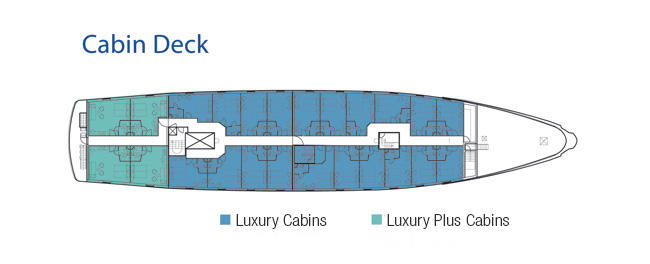


- Reconstruted & refitted: Callao, Peru in 2007
- Length: 63.87 metres (209 ft.)
- Beam: 12.50 metres (41 ft.)
- Gross Tonnage: 1,438.25 tons
- Speed: 10 knots
- Capacity: 48 guests
- Cabin: 24 outside cabins, on the same Deck with twin or queen-size beds
- Double Cabin size: 16 square metres (175 square feet)
- Triple cabin size: 22 square metres (236 square feet) with sofa bed
- Decks: Three public decks include an ample Bar-salon, dining room, natural history library, sky bar and sundeck
- Wellness: Jacuzzi, Fitness room
- Type of Vessel: Motor Yacht
- Electricity: 110-220 volts 50Hz
- Engines: 2 DEUTZ Model SBA 8M 1275 HP
- Navigation Equipment: Gyrocompass, Automatic Pilot, radar and GPS
- Communications Systems: Inmarsat C, Satellite Internet
- Safety Certificates: SOLAS, STCW, MARPOL, ISM CODE 12
- Fire Detector: Automatic with control from the bridge
- Life Jackets: In each cabin
- Inflatable Life Craft: 2 x 50-man and 6 x 25-man
- Landing Craft: 4 Pumar inflatable craft + glass bottom boat
- Owner: ETICA (Metropolitan Touring)
- Decks: 3 (Sun Deck, Cabin Deck, Main Deck)
- Crew: 27 (Including officers)
- Naturalist Guides: 4 (including Expedition Manager)
- Medical Officer: Permanently on board
Please contact us to learn about the latest deals.




